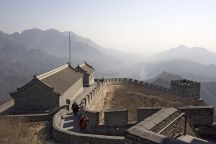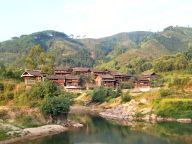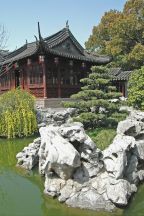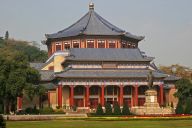|
Chinese Cooking - An Overview

In Summarising Chinese cooking, Confucious said : "Rice affected by the weather or turned a man must not eat, nor fish that is not sound, nor meat that is high. He must not eat anything discolored or that smells bad. He must not eat what is overcooked, nor what is undercooked, nor anything that is out of season. He must not eat what has been crookedly cut, nor any dish that lacks its proper seasoning. The meat he eats must at the very most not be enough to make his breath smell of meat rather than rice. As regards wine, no limit is laid down: but he must not be disorderly." From "THE ANALECTS OF CONFUCIOUS" Time has minimized the influence that the teachings of Confucious exert on the Chinese of today, especially the young who resent his high-morality preachings. However, his outlook on eating and enjoying one's drink is embraced by all. It is actually the basic key to the perfect balance between culinary delight and healthy consumption.
It's not suprising that this sage advice comes from a member of the population of a country that feeds the majority of the world's largest ethnic group on a daily basis. The Chinese don't eat for the sake of merely filling their stomachs, rather every meal is viewed as an occassion unto itself, and each dish is prepared to stimulate not just the taste buds, but all the senses. Perhaps because of the rural nature of China and the prevelence of poverty among the majority of the population for so many thousands of years, they have learned to enjoy the simple things in life and to make the absolute most of them. And they do! Chinese cuisine is now considered to be one of the top two respected cuisines of the world along with French, and Chinese cooking has indeed developed into a very fine art. It is one of the world's oldest civilizations, and the Chinese chef has had many thousands of years to develop his craft.
Another reason for the magnificence of Chinese cooking is the size and diversity of the country and its climate. China is the fourth largest country in the world behind Russia, Canada and the United States, and its range of climates exceeds all of theirs. This biodiversity provides and assortment of different living conditions, crops and ingredients, resources, and consequently different styles of cooking. Let's briefly look at the four major styles of Chinese cooking Honan (Peking), Szechwan, Fukien and Cantonese, which are named after the areas where they have developed. Did You Know That The Sauces You Love From Your Favorite Restaurants Can Now Be Made At Home In As Little As 20 Minutes. It's Easier Than You Think, Stop Paying Those Astronomical Restaurant Prices and Make Your Own Gourmet Sauces at Home!Learn How!

Hunan (Peking) The Hunan style of cooking developed in northern China in Peking, Shantung and Hunan. It was here that dishes like Peking Duck were developed for emperors, who recruited the finest chefs in the land and encouraged them to be creative and experimental. Honan is famous for its sweet and sour fish made from carp caught in the Yellow River. The traditional crop of Hunan is rice and tea is also a staple of Hunan province due to its mountainous terrain. Because of its proximity to Mongolia, it was here that lamb was first introduced to Chinese cooking. It has remained a local favorite ever since, spawnig such delicacies as the Mongolian grill - an indoor barbecue where thin strips of mutton are roasted over an open charcoal fire. The harsh landscape of Hunan province encourages certain characteristics in this style of Chinese cooking. Massive preparation rituals are sometimes followed such as extended marinating and smoking before the final preparation is made. Rice is the staple grain of Hunan province and features regularly in its cuisine. The spiciness of Honan dishes come from the local chili peppers and Hunan chefs are apt to make use of the spicy seeds to soup up their creations. Garlic is featured regularly in Hunan style food and pork is another favorite meat of the area.

Szechwan and its neighboring provinces are home to the Szechwan pepper, and as such is known for its fiery, spicy dishes. Szechwan Duck, though not as famous in Chinese cuisine circles as its famous neighbor Peking to the north, is a notable recipe from this area. The duck is spiced with Szechwan pepper, steamed to remove the fat, and then deep fried; the resultant meat being melt-in-your-mouth tender. Besides the heavy use of peppers in this spicy style, garlic, peanuts, ginger and sesame paste are prominent ingredients. The original spiciness of this type of Chinese cooking did not come from the famous chilli pepper, but the endemic Szechuan pepper which is actually a type of berry. The reddish-brown fruit is one of the main ingredients of five spice powder and though not as hot as chili peppers is known for the numbing effect it has on the palate. It is not clear how the foreign chili pepper was introduced to Szechuan province, but it is most likely it was carried across the mountains from India, perhaps by Buddha as part of his healing package. Regardless of how they arrived, they have been cleverly integrated into the Szechuan style of Chinese cooking and are now a sought after culinary delight. Szechuan province and the surrounding territories have been inhabited for at least 3,000 years. That endurance is reflected in the wealth of hearty and interesting recipes which distinguish the cuisine from other types of Chinese cooking. The variety of inhabitants over that time has fluctuated also, and the many different cultures to inhabit Szechuan province have all contributed their own character to one of the “Four Great Traditions” of Chinese cooking. One of the most famous chefs of the Szechuan style is Chen Kinichi of the “Iron Chef” television series.
Get Szechwan Style Recipes Here

Fukien The mountainous coastal province of Fukien is famous for its seafood dishes and its breakfast dish of hot rice porridge called “congee.” Because of the hilly terrain, farmland is scarce, but rice, wheat and sweet potatoes grow in abundance. Not surprisingly noodles are a standard side dish of Fukien style chinese cooking. The Fukien style of Chinese cooking embraces dishes form Fukien in the south (adjacent to Taiwan) up to Shanghai in the north (bordering the East China Sea). Fukien produces China's best soy sauce and so dishes from this area are comprised of lots of stews and soups. Supreme spring rolls are another of Fukien's contributions to Chinese cuisine, and its pork and chicken dishes are amongst the best. The cooks on the coast in the Shanghai area naturally produce lots of seafood dishes, but spiced blends of meat,chicken and duck combined with a multitude of vegetables are produced here. The most famous of this area's contributions to Chinese cooking is the reknowned Bird's Nest Soup. Bird’s nest soup incorporates some rather bizarre, exotic ingredients, but this is typical of Fukien recipes. Perhaps a lesser known complex example of the Fukien style of Chinese cooking best exemplifies this. Translated into English as “Buddha Jumps Over the Wall,” the dish know locally as Fotiaoqiang contains shark fin, sea cucumber, abalone and Shaoxing wine, famously used in the “drunken dishes” of Chinese cuisine such as; Drunken Chicken and Drunken Shrimp.

Canton Everyone is familiar with egg rolls, egg foo young and dim sum. These are all Cantonese recipes brought to America and the West by the first Chinese to emigrate in large numbers. Cantonese is one of the most colorful styles of Chinese cooking, mostly due to the fact that they use less of, and a lighter colored version of soy sauce, so the hues of the other ingredients are allowed to shine through. There is a variety of styles within this style of Chinese cuisine, partly because of the abundance of resources, and partly from the incorporation of the other three major styles into their cuisine by chefs from those areas who have migrated there. The Cantonese style of Chinese cuisine is known as the Southern School and is considered by many to be the finest of China’s culinary techniques. Famous for its sweet and sour dishes, the Cantonese style of Chinese cookery is also famous for is incorporation of exotic ingredients like snake and frog’s legs into its recipes. Hoisin and oyster sauces are used regularly in Cantonese dishes, and slightly undercooked vegetables add crispness and natural color and flavoring to the recipes of this region.
Get Cantonese Style Recipes Here
Because of the diversity of climates and terrain, the various regions of China all produce different ingredients which influence local cuisine. The food resources available to the Chinese have been expertly integrated into every style of Chinese cuisine, unmatched by any other culture. In spite of the climate and terrain differences, and thus the variance in available ingredients, the philosophy of Chinese cooking has remained the same across the country. Shared techniques are used throughout China, no matter the region, and variations and adaptations using only what is available to a particular region have resulted in a uniqueness, yet similarity of styles that is duplicated nowhere else in the world. Every region though has its own authentic dishes with their own unique tastes, and that authenticity can only be attained by the use of unique ingredients that are sometimes difficult to find outside of a particular area. There are ingredients that may be substituted in any style of cooking, but authenticity is in turn sacrificed. The link below will lead you to a list of authentic ingredients used in Chinese cooking. Where there is an acceptable substitute it is listed, but the focus here is on authentic ingredients rather than the recipes in which they are used. Specific ingredient substitutes are mentioned along with the recipes in which they are required on our regional recipe pages.
View All of the Chinese Cooking Ingredients Here
Back to Homepage from Chinese Cooking
|



